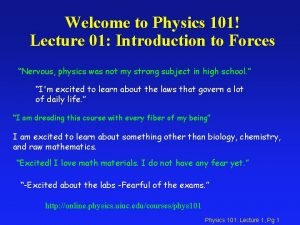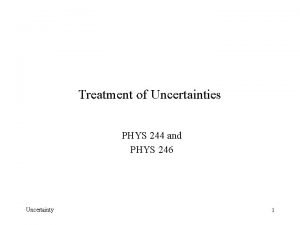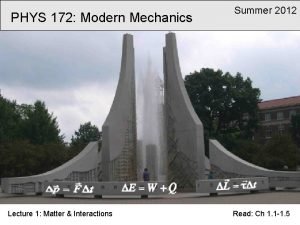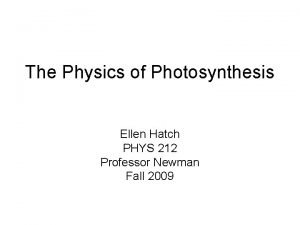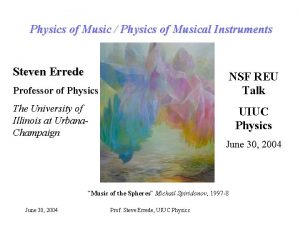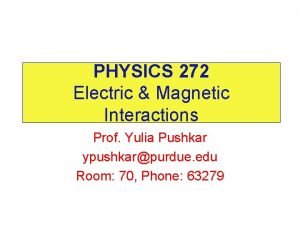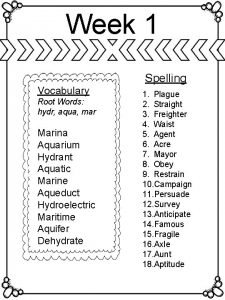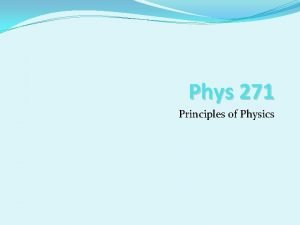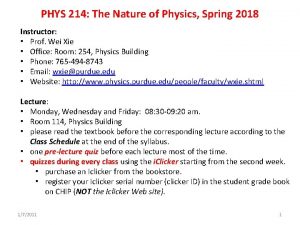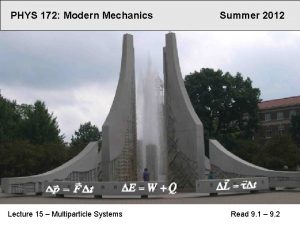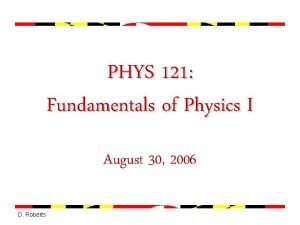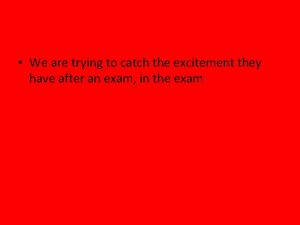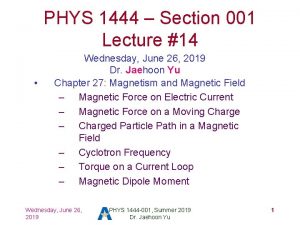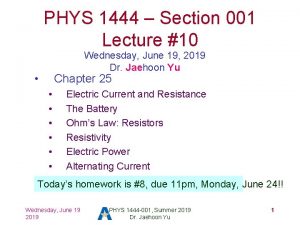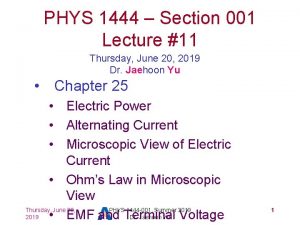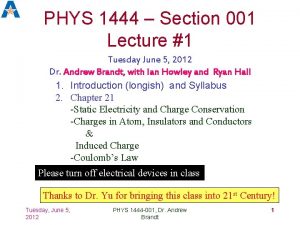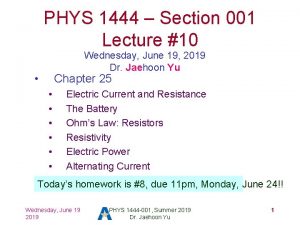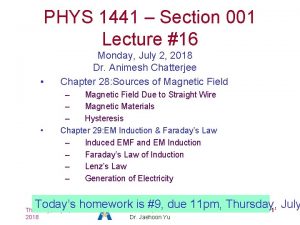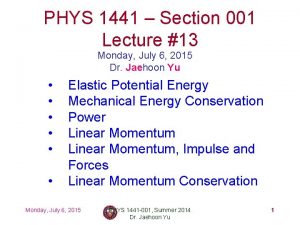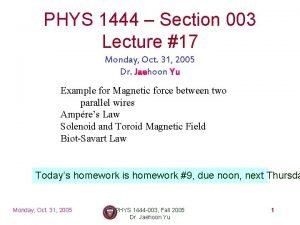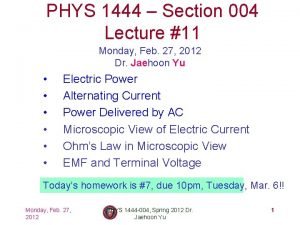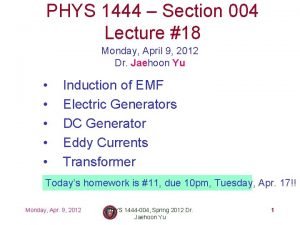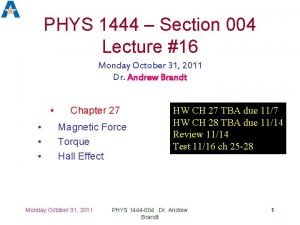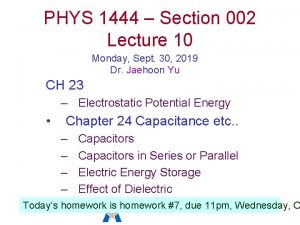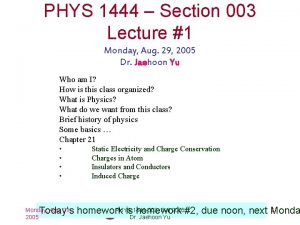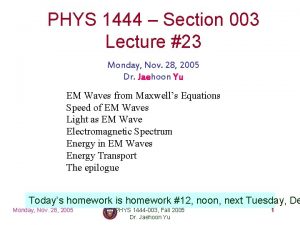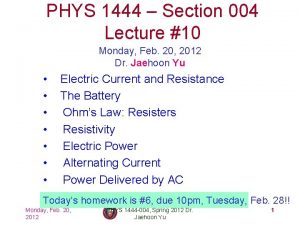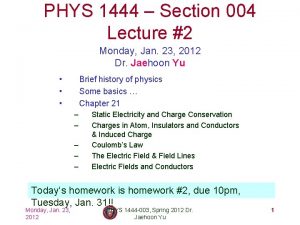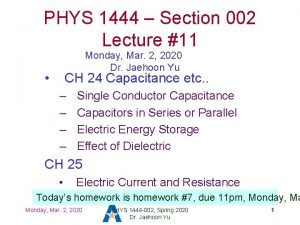PHYS 1444 Section 001 Lecture 16 Monday July




















- Slides: 20

PHYS 1444 – Section 001 Lecture #16 • • Monday, July 1, 2019 Dr. Jaehoon Yu Chapter 28: Sources of Magnetic Field – Solenoid and Its Magnetic Field – Magnetic Materials – Hysteresis Chapter 29: EM Induction & Faraday’s Law – Induced EMF and EM Induction – Faraday’s Law of Induction – Lenz’s Law – Generation of Electricity Monday, July 1, 2019 PHYS 1444 -001, Summer 2019 Dr. Jaehoon Yu 1

Announcements • Final Exam – In the class for 120 min this Wednesday, July 3 – Covers CH 21. 1 – What we finish tomorrow, Tuesday, July 2 + Maxwell’s equations – BYOF: You may prepare one 8. 5 x 11. 5 sheet (front and back) of handwritten formulae and values of constants for the exam – No derivations, word definitions, setups or solutions of any problems! – No additional formulae or values of constants will be provided! • Be sure to bring your planetarium extra credit and submit at the beginning of the exam this Wednesday, July 3 – Tape one side of the ticket stub on a sheet of paper with your name on • Remember the triple extra credit for seminar at 4 pm tomorrow in SH 103 • Course evaluation: Let’s do this during the break • Reading CH 29. 5 29. 8 Monday, July. Assignments: 1, 2019 PHYS 1444 -001, and Summer 2019 2 Dr. Jaehoon Yu

Solenoid and Its Magnetic Field • What is a solenoid? – A long coil of wire consisting of many loops – If the space between loops are wide • The field near the wires are nearly circular • Between any two wires, the fields due to each loop cancel • Toward the center of the solenoid, Solenoid the fields add up Axis to give a field that can be fairly large and uniform – For a long, densely packed loops • The field is nearly uniform and parallel to the solenoid axes within the entire cross section • The field outside the solenoid is very small compared to the field inside, except the ends – The same number of field lines spread out to an open Monday, July space 1, 2019 PHYS 1444 -001, Summer 2019 Dr. Jaehoon Yu 3

Solenoid Magnetic Field • Now let’s use Ampere’s law to determine the magnetic field inside a very long, densely packed solenoid • Let’s choose the path abcd, far away from the ends – We can consider four segments of the loop for integral – – The field outside the solenoid is negligible. So the Monday, integral July 1, 2019 on a b PHYS Summer 2019 is 1444 -001, 0. Dr. Jaehoon Yu 4

Solenoid Magnetic Field – So the sum becomes: – If the current I flows in the wire of the solenoid, the total current enclosed by the closed path is NI • Where N is the number of loops (or turns of the coil) enclosed – Thus Ampere’s law gives us – If we let n=N/l be the number of loops per unit length, the magnitude of the magnetic field within the solenoid becomes – • B depends on the number of loops per unit length, n, and the current I Monday, July 1, 2019 PHYS 1444 -001, Summer 2019 5 – Does not depend on the position within the solenoid but Dr. Jaehoon Yu

• Magnetic Materials Iron is a material that can turn into a strong magnet Ferromagnetism – This kind of material is called the ferromagnetic material • In microscopic sense, ferromagnetic materials consist of many tiny regions called domains – Domains are like little magnets usually smaller than 1 mm in length or width • What do you think the alignment of domains are like when they are not magnetized? – Randomly arranged • What if they are magnetized? – The size of the domains aligned with the external magnetic field direction grows while those of the domains not aligned reduce – This gives magnetization to the material • How do we demagnetize a bar magnet? – Hit. July the 1, magnet Monday, 2019 hard. PHYS or heat it over the 2019 1444 -001, Summer Curie temperature Dr. Jaehoon Yu 6

• • B in Magnetic Materials What is the magnetic field inside a solenoid? – Magnetic field in a long solenoid is directly proportional to the current. – This is valid only if air is inside the coil • What do you think will happen to B if we have something other than the air inside the solenoid? – It will be increased dramatically, when the current flows • Especially if a ferromagnetic material such as an iron is put inside, the field could increase by several orders of magnitude • Why? – Since the domains in the iron aligns permanently by the external field. – The resulting magnetic field is the sum of that due to current and due to the iron Monday, July 1, 2019 PHYS 1444 -001, Summer 2019 Dr. Jaehoon Yu 7

B in Magnetic Materials • It is sometimes convenient to write the total field as the sum of two terms • – B 0 is the field due only to the current in the wire, namely the external field • The field that would be present without a ferromagnetic material – BM is the additional field due to the ferromagnetic material itself; often BM>>B 0 • The total field in this case can be written by replacing μ 0 with another proportionality constant μ, the magnetic permeability of the material – μ is a property PHYS of a 1444 -001, magnetic material Summer 2019 Monday, July 1, 2019 Dr. Jaehoon Yu 8

• Hysteresis Iron C ore To What is a toroid? r – A solenoid bent into a shape oid • Toroid can be used for magnetic field measurement – Why? – Since it does not leak magnetic field outside of itself, it fully contains all the magnetic field created within it. • Consider an un-magnetized iron core toroid, without any current flowing in the wire – What do you think will happen if the current slowly increases? – B 0 increases linearly with the current. – And B increases also but follows the curved line shown in the graph – As B 0 increases, the domains become more aligned until Monday, July 1, 2019 PHYS 1444 -001, Summer 2019 9 nearly all are aligned (point b on the graph) Dr. Jaehoon Yu

Hysteresis • What do you think will happen to B if the external field B 0 is reduced to 0 by decreasing the current in the coil? – Of course it goes to 0!! – Wrong! They do not go to 0. Why not? – The domains do not completely return to the random alignment state • Now if the current direction is reversed, the external magnetic field direction is reversed, causing the total field B pass 0, and the direction reverses to the opposite side – If the current is reversed again, the total field B will increase but never goes through the origin • This kind of curve whose path does not retrace themselves and does not Monday, July 1, 2019 PHYS Summer 2019 go through the origin is 1444 -001, called the Dr. Jaehoon Yu 10

Magnetically Soft Material • In a hysteresis cycle, much energy is transformed to thermal energy. Why? – Due to the microscopic friction between domains as they change directions to align with the external field • The energy dissipated in the hysteresis cycle is proportional to the area of the hysteresis loop • Ferromagnetic material with large hysteresis area is called magnetically hard while the small ones are called soft – Which one do you think are preferred in electromagnets or transformers? • Soft. Why? • Since the energy loss is small and much easier to switch off the field • Then how do we demagnetize a ferromagnetic Monday, July 1, 2019 material? PHYS 1444 -001, Summer 2019 Dr. Jaehoon Yu – Keep repeating the Hysteresis loop, reducing the 11

Induced EMF • It has been discovered by Oersted and company in early 19 th century that – Magnetic field can be produced by the electric current – Magnetic field can exert force on the electric charge • So if you were scientists at that time, what would you wonder? – Yes, you are absolutely right! You would wonder if the magnetic field can create the electric current. – An American scientist Joseph Henry and an English scientist Michael Faraday independently found that it was possible • Though, Faraday was given the credit since he published his work before Henry did – He also did a lot of detailed studies on magnetic induction Monday, July 1, 2019 PHYS 1444 -001, Summer 2019 Dr. Jaehoon Yu 12

Electromagnetic Induction • Faraday used an apparatus below to show that magnetic field can induce current • Despite his hope, he did not see steady current induced on the other side when the switch is thrown • But he did see that the needle on the Galvanometer turns strongly when the switch is initially thrown and is opened – When the magnetic field through coil Y changes, a current flows as if there were a source of emf July 1, 2019 PHYS 1444 -001, Summer 2019 • Monday, Thus he concluded that an induced emf is Dr. Jaehoon Yu 13

Electromagnetic Induction • Further studies on electromagnetic induction taught – If a magnet is moved quickly into a coil of wire, a current is induced in the wire in one direction – If a magnet is removed from the coil, a current is induced in the wire in the opposite direction – By the same token, the current can also be induced if the magnet stays put but the coil moves toward or away from the magnet – Current is also induced if the coil rotates. • In other words, it does not matter whether the magnet or the coil moves. It is the relative motion that counts. Monday, July 1, 2019 PHYS 1444 -001, Summer 2019 Dr. Jaehoon Yu 14

Magnetic Flux • So what do you think is the induced emf proportional to? – The rate of changes of the magnetic field? • the higher the changes the higher the induction – Not really, it rather depends on the rate of change of the magnetic flux, flux ΦB. – Magnetic flux is defined as (just like the electric flux) – • θ is the angle between B and the area vector A whose direction is perpendicular to the face of the loop based on the right-hand rule – What kind of quantity is the magnetic flux? • Scalar. Unit? • or weber 1, 2019 1444 -001, Summer 2019 • Monday, If the. Julyarea of the. PHYS loop is not simple or B is not Dr. Jaehoon Yu 15

Faraday’s Law of Induction • In terms of magnetic flux, we can formulate Faraday’s findings – The emf induced in a circuit is equal to the rate of change of magnetic flux through the circuit Faraday’s Law of Induction • If the circuit contains N closely wrapped loops, the total induced emf is the sum of emf induced in each loop – Why negative? • Has got a lot to do with the direction of induced emf… Monday, July 1, 2019 PHYS 1444 -001, Summer 2019 Dr. Jaehoon Yu 16

Lenz’s Law • It is experimentally found that – An induced emf gives rise to the current whose magnetic field opposes the original change in flux This is known as Lenz’s Law – In other words, an induced emf is always in the direction that opposes the original change in flux that caused it. – We can the usemagnet Lenz’sis law to explain the following cases in • When moving into the coil the figures – Since the external flux increases, the field inside the coil takes the opposite direction to minimize the change and causes the current to flow clockwise • When the magnet is moving out – Since the external flux decreases, the field inside the coil takes the opposite direction to compensate the loss, causing the current to flow counter-clockwise • Which law is Lenz’s law result of? – Energy conservation. Why? Monday, July 1, 2019 PHYS 1444 -001, Summer 2019 Dr. Jaehoon Yu 17

Induction of EMF • How can we induce emf? • Let’s look at the formula for the magnetic flux • • What do you see? What are things that can change with time to result in change of magnetic flux? – Magnetic field – The area of the loop – The angle θ between the field and the area Monday, July 1, 2019 PHYS 1444 -001, Summer 2019 vector Dr. Jaehoon Yu 18

Example 29 – 5 Pulling a coil from a magnetic field. A square coil of wire with side 5. 00 cm contains 100 loops and is positioned perpendicular to a uniform 0. 600 -T magnetic field. It is quickly and uniformly pulled from the field (moving perpendicular to B) to a region where B drops abruptly to zero. At t=0, the right edge of the coil is at the edge of the It takes 0. 100 s wholethe coil, (b) the emf and region. Find (a) field. the rate of change in for fluxthe through to theinduced, field-freeand (c) how much energy is dissipated in the coil if its thereach current resistance is 100Ω. (d) what was the average force required? What should be computed first? The flux at t=0 is The change of flux is The initial flux at t=0. Thus the rate of change of the flux is Monday, July 1, 2019 PHYS 1444 -001, Summer 2019 Dr. Jaehoon Yu 19

Example 29 – 5, cnt’d Thus the total emf induced in this period is The induced current in this period is Which direction would the induced current The totalflow? energy dissipated is Force for each coil is Monday, July 1, 2019 Clockwis e Force for N coil is PHYS 1444 -001, Summer 2019 Dr. Jaehoon Yu 20
 First world country
First world country Monday 13th july
Monday 13th july Physics 241 purdue
Physics 241 purdue 01:640:244 lecture notes - lecture 15: plat, idah, farad
01:640:244 lecture notes - lecture 15: plat, idah, farad Phys 102 uiuc
Phys 102 uiuc Taekjip
Taekjip Physics courses ucsd
Physics courses ucsd Calculating a percent difference
Calculating a percent difference Phys 172
Phys 172 Http //www.phys.hawaii.edu/ teb/optics/java/slitdiffr/
Http //www.phys.hawaii.edu/ teb/optics/java/slitdiffr/ Http //vsg.quasihome.com
Http //vsg.quasihome.com Phys 212 equation sheet
Phys 212 equation sheet Phys 398 uiuc
Phys 398 uiuc Nano coloumb
Nano coloumb In the term antipyretic the root pyret means
In the term antipyretic the root pyret means Vis root word list
Vis root word list Mastering physics login
Mastering physics login Phys 214
Phys 214 Phys 172
Phys 172 Phys 121 umd
Phys 121 umd Eosc 110 pre class quiz
Eosc 110 pre class quiz





